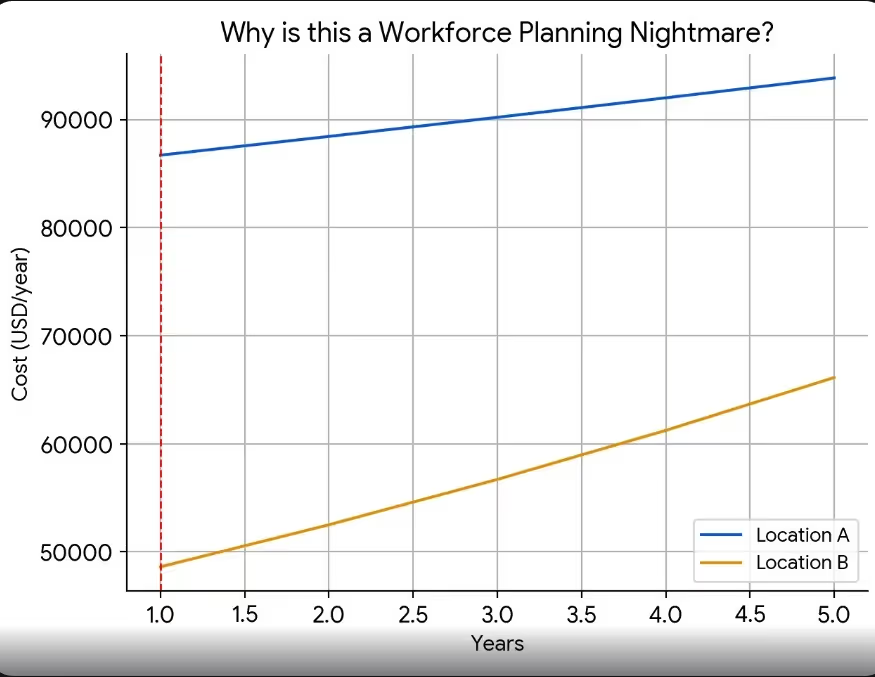Beyond Supply and Demand: Revolutionizing Workforce Planning with Comprehensive Talent Insights
Hope you are doing well. Many research questions related to the labor market necessitate longitudinal studies, which involve monitoring individuals or groups over a period of time. This approach is crucial for understanding various aspects of labor dynamics, including:
Worker Flow: This refers to the movement of workers in and out of employment, between jobs, or in and out of the labor force. Longitudinal data helps to track these flows over time, providing insights into employment stability, job transitions, and labor market liquidity.
Skills Mobility involves workers’ movement between jobs, industries, or geographic locations. Tracking individuals over time helps to understand the factors influencing job changes, such as career progression, skill development, or economic conditions.
Wage Behavior: Longitudinal studies are essential for examining how wages change over time for the same skills. This can reveal trends in wage growth, the impact of inflation, and the effects of changes in labor market conditions or government policies on individual earnings.
Migration Decisions: Understanding the migration patterns of workers requires following them over time to see how and why they relocate for employment opportunities. This can provide insights into labor market dynamics, regional economic development, and the impact of migration on both origin and destination areas.
Progressions of the Location: Bengaluru – India, initially established as a hub for IT services, has evolved into a global center for product development. This transformation occurred as the region’s professionals progressed to more sophisticated and complex projects. Similarly, Phoenix and Dallas in the United States possess comparable opportunities. These cities currently host a significant amount of IT service activities, providing a strong foundation for their potential transition into major hubs for product development. With the right investments and focus on innovation, they can follow in Bengaluru’s footsteps and become influential players in the global technology landscape. In Europe, Dublin in Ireland is a good example of a city transitioning from primarily focused on IT services to becoming a global technology and product development hub. Dublin is home to the European headquarters of several major tech companies, including Google, Facebook, and Microsoft. The city has fostered a vibrant tech ecosystem supported by a strong talent pool from local universities and favorable government policies. This environment has encouraged innovation and the development of a wide range of tech products, positioning Dublin as a key player in the global technology industry.
To arrive at an effective Workforce Planning that will be helpful for Recruiters’ a mere analysis of supply and demand as a standard set of metrics may not be helpful. This is the primary reason why we at Draup are creating various knowledge vectors addressing all aspects of Talent.
A standard set of supply and demand metrics may not suffice to develop an effective workforce planning strategy that benefits recruiters. This is why we at Draup create various knowledge vectors that address all aspects of Talent. Our approach ensures a comprehensive understanding of the workforce landscape, enabling recruiters to make informed decisions and effectively meet their hiring needs.
We often encounter scenarios I call a Workforce Planners nightmare in location analysis. This graph represents this scenario well (thanks to the Google Gemini Advanced model for excellent charting capabilities ). A simple scenario that we are often familiar with is shown here. A case of a high-cost option with a low-cost option. A quick decision may favor Location B, but “Forward-Looking Scenarios” may tell a different story.

I refer to this as a nightmare scenario because even with all the challenges, we may sometimes have no option other than to choose Location B. Here is the summary (a practitioner view that I sought in this case study)
Rapid Inflation: The graph highlights how quickly labor costs can become unmanageable in certain locations. Location B’s rapid inflation rate means a seemingly great deal today could become a budget-busting expense within a few years.
Difficulty Budgeting: This unpredictability makes it extremely challenging for businesses to forecast their labor expenses accurately. Unexpected cost increases can disrupt long-term financial planning and hinder future growth or investment.
Strategic Blind Spots: Failure of Due Diligence: The graph suggests a potential lack of thorough research into long-term cost projections. To make informed location decisions, businesses must understand how inflation might vary across geographies.
Strategic Blind Spots: Hidden Factors: The graph focuses solely on cost, but factors like labor pool availability, skillsets, and local regulations all play into workforce planning. Overlooking these due to a perceived cost advantage can backfire.
Developing a hyper-forward-looking database is crucial for recruiters aiming to future-proof their talent acquisition strategies. Such databases are designed to capture current candidate information and predict future trends and skills requirements. We developed this table using attendees and presenters in AI conferences. Such new data sources will be very helpful in understanding and tapping new Talent.

Overall, we are pretty excited about HR’s role under emerging circumstances. If we plan the initiatives correctly, we can accelerate transformation and adaptation and make the enterprises genuinely care for a great workplace. Thanks again for reading. Please stay safe; we will return with more insights next week.










.svg)




















.svg)





.svg)
